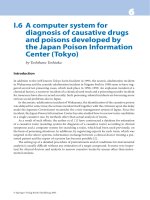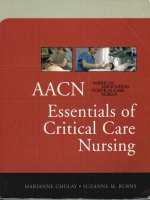CURRENT ESSENTIALS OF CRITICAL CARE - PART 6 ppt
Bạn đang xem bản rút gọn của tài liệu. Xem và tải ngay bản đầy đủ của tài liệu tại đây (172.1 KB, 32 trang )
Nonbacterial Meningitis
■
Essentials of Diagnosis
•
Acute onset of headache, mild neck stiffness, fever (viral menin-
gitis); chronic symptoms with gradual increase in severity over
days to weeks (tuberculous or fungal meningitis)
•
May have features of underlying disease (viral syndrome or pul-
monary or disseminated tuberculosis or fungal infection)
•
Viral meningitis: acute onset, resolves within days; cere-
brospinal fluid with predominance of lymphocytes, normal glu-
cose; enteroviruses most commonly implicated
•
Tuberculous meningitis: subacute or chronic onset of symptoms;
cerebrospinal fluid with predominance of lymphocytes, low glu-
cose, high protein
•
Fungal meningitis: subacute or chronic onset of symptoms; cere-
brospinal fluid has predominance of lymphocytes; variably low
glucose and high protein (Coccidioides immitis); in Cryptococ-
cus neoformans meningitis, symptoms, signs often unremark-
able; may have high CSF opening pressure and positive CSF
India ink stain, but normal glucose, protein, cell counts
■
Differential Diagnosis
•
Carcinomatous meningitis
•
Partially treated bacterial meningitis
•
Drug-induced meningitis
■
Treatment
•
No specific treatment for viral meningitis
•
Tuberculous meningitis: begin empiric therapy with 3–4 antitu-
berculous drugs
•
Cryptococcal meningitis: amphotericin B plus 5-flucytosine fol-
lowed by fluconazole
•
Coccidioides meningitis: high dose fluconazole, or flucona-
zole ϩ amphotericin B
■
Pearl
Mumps, Herpes simplex, and lymphochoriomeningitis (LCM) menin-
goencephalitis may cause low CSF glucose levels.
Reference
Beaman MH: Acute community-acquired meningitis and encephalitis. Med J
Aust 2002;176:389. [PMID: 12041637]
148 Current Essentials of Critical Care
5065_e10_p131-158 8/17/04 10:27 AM Page 148
Nosocomial Pneumonia
■
Essentials of Diagnosis
•
Common nosocomial infection, with mortality rate up to 70%
•
Aspiration of oropharyngeal material most common route of ac-
quisition; oropharynx often colonized with gram-negative, hos-
pital-acquired organisms; 20–40% polymicrobial
•
Risk factors: neurologic impairment, mechanical ventilation,
witnessed aspiration, lung and heart disease, supine position,
older age, nasogastric tube
•
Less commonly, inhalation and nosocomial acquisition of tu-
berculosis, legionellosis, influenza, aspergillosis
•
Nosocomial bacteremia with Staphylococcus aureus and Can-
dida spp can lead to hematogenous pneumonia
■
Differential Diagnosis
•
Acute respiratory distress syndrome
•
Pulmonary emboli
•
Cardiogenic pulmonary edema
•
Malignancy (primary lung or metastatic disease)
•
Atelectasis
■
Treatment
•
Antibiotic therapy targeting local nosocomial flora
•
Sputum Gram stain, culture may guide therapy; quantitative en-
dotracheal aspirate (sensitivity 52–100%), bronchoalveolar
lavage (80–100%), protected brush specimen (65–100%) more
useful
•
Supportive care with frequent suctioning of respiratory secre-
tion, postural drainage and, in some patients, bronchoscopy for
drainage
•
Use preventive measures such as semirecumbent position (ele-
vate head of bed), avoid long-term nasal intubation, use frequent
supraglottic suctioning
■
Pearl
Consider nosocomial pulmonary aspergillosis in neutropenic patients.
Reference
Johanson WG: Nosocomial pneumonia. Intens Care Med 2003;29:23. [PMID:
12528018]
Chapter 10 Infectious Disease 149
5065_e10_p131-158 8/17/04 10:27 AM Page 149
Peritonitis
■
Essentials of Diagnosis
•
Spontaneous bacterial peritonitis (SBP); or secondary peritoni-
tis from perforation of abdominal viscus
•
SBP defined as ascitic fluid with Ͼ250 neutrophils/mm
3
or pos-
itive Gram stain (rarely) or culture of ascitic fluid; 50% with
fever, abdominal tenderness; 30% asymptomatic
•
SBP seen in 8–27% of patients with cirrhosis and ascites; likely
due to translocation of bacteria across gut lumen; E coli most
common, then K pneumoniae, streptococci, enterococci, anaer-
obes; mortality up to 50%
•
Secondary peritonitis patients have severe abdominal pain, nau-
sea, vomiting, fever, abdominal tenderness, hypotension; sec-
ondary to perforation of viscus; ascitic fluid with leukocytosis,
Gram stain and cultures polymicrobial; abdominal radiographs
or CT scan may show free intraperitoneal air
■
Differential Diagnosis
•
Appendicitis, intra-abdominal abscess
•
Sickle cell crisis
•
Diabetic ketoacidosis
•
Porphyria
•
Familial Mediterranean fever
•
Lead poisoning
•
Uremia
•
Systemic lupus erythematosus with serositis
■
Treatment
•
SBP, use third-generation cephalosporin
•
Secondary peritonitis requires evaluation and surgical manage-
ment for perforated viscus; antibiotic coverage must include
anaerobes and enteric gram-negative bacilli
■
Pearl
Suspect secondary peritonitis if more than one microorganism on
Gram stain or culture of ascitic fluid.
Reference
Malangoni MA: Current concepts in peritonitis. Curr Gastroenterol Rep
2003;5:295. [PMID: 12864959]
150 Current Essentials of Critical Care
5065_e10_p131-158 8/17/04 10:27 AM Page 150
Pneumocystis jiroveci Pneumonia (PCP)
■
Essentials of Diagnosis
•
Nonproductive cough, fever, progressive dyspnea; chest radio-
graph with interstitial infiltrates, often bilateral
•
Arterial hypoxemia, sometimes out of proportion to chest ra-
diographic findings
•
Diagnosis confirmed by Giemsa or methenamine silver stain or
immunofluorescent antibody stain of sputum or bronchoalveo-
lar lavage
•
Commonly seen in patients with advanced HIV infection, low
CD
4
cell count, and those not receiving Pneumocystis prophy-
laxis
•
Prolonged administration of corticosteroids associated with in-
creased risk in HIV-negative hosts
■
Differential Diagnosis
•
Bacterial, viral, or fungal pneumonia
•
Tuberculosis
•
Congestive heart failure
•
Acute respiratory distress syndrome
•
Pulmonary emboli
■
Treatment
•
High-dose trimethoprim-sulfamethoxazole (15 mg/kg/day of
trimethoprim component)
•
Alternatives: atovaquone, clindamycin plus primaquine, dap-
sone plus trimethoprim, pentamidine
•
Oxygen or mechanical ventilation, if indicated, for respiratory
failure
•
Adjunctive therapy with corticosteroids if P(AϪa)O
2
Ͼ35 mm
Hg or PO
2
Յ 70 mm Hg
•
For HIV-infected patients, secondary prophylaxis against Pneu-
mocystis until CD4 count consistently Ͼ200 cells/mm
3
with an-
tiretroviral therapy
■
Pearl
A patient with suspected PCP who has a normal serum LDH should
be evaluated for an alternative diagnosis.
Reference
Morris A: Improved survival with highly active antiretroviral therapy in HIV-
infected patients with severe Pneumocystis carinii pneumonia. AIDS
2003;17:73. [PMID: 12478071]
Chapter 10 Infectious Disease 151
5065_e10_p131-158 8/17/04 10:27 AM Page 151
Prevention of Nosocomial Infection
■
Essential Concepts
•
Infection acquired in hospital (not present or incubating at the
time of admission); onset at least 2–4 days after hospitalization
depending on site and pathogen identified
•
Manifestations specific for site and source
•
Occurs in 5–35% of ICU patients; most common urinary tract
infection, pneumonia, surgical site infection, bloodstream
•
Sources: bacterial flora colonizing patients, with pathogens in-
creasingly resistant to antibiotics, and patient’s endogenous flora
■
Essentials of Management
•
Prevent cross-contamination using universal precautions (hand
washing; gloves, masks, gowns when necessary; special care
with patient soiled linen and removed devices); appropriate iso-
lation of patients with easily transmissible pathogens (C diffi-
cile, M tuberculosis) or highly resistant pathogens (methicillin-
resistant S aureus, vancomycin-resistant enterococcus)
•
Appropriate use of antimicrobial agents to limit selection of re-
sistant pathogens
•
Ventilator-associated pneumonia: use semirecumbent rather
than supine positioning, sucralfate rather than antacid therapy
for prevention of stress gastritis (controversial), continuous sub-
glottic aspiration, noninvasive ventilation when possible
•
Nosocomial sinusitis: limit duration of nasogastric or nasola-
ryngeal tubes; oral hygiene
•
Bloodstream infection: use careful sterile technique in insertion
and handling of devices; use “tunneled” catheters for long-term
intravenous use; minimize use of femoral venous catheters; con-
sider use of antimicrobial impregnated catheters in selected pa-
tients
•
Urinary tract infection: use indwelling urinary catheter only
when necessary; reassess need daily, discontinue if possible
•
Surgical site infections: stress optimal sterile surgical tech-
niques; antimicrobial prophylaxis when and only if appropriate
■
Pearl
Hand washing is the single most effective method to avoid nosoco-
mial transmission of pathogens.
Reference
Eggimann P: Infection control in the ICU. Chest 2001;120:2059. [PMID:
11742943]
152 Current Essentials of Critical Care
5065_e10_p131-158 8/17/04 10:27 AM Page 152
Pulmonary Infections in HIV-Infected Patients
■
Essentials of Diagnosis
•
Pneumococcal or other bacterial pneumonia: abrupt onset of pro-
ductive cough, fever, pleuritic chest pain (pneumococcal or other
bacterial pneumonia)
•
Tuberculous or fungal pneumonia (including Pneumocystis
jiroveci): more gradual onset of fever, less purulent sputum,
cough, weight loss
•
Pneumocystis pneumonia: gradual onset of dyspnea, fever, no
or very minimal sputum
•
Chest radiographic findings vary from focal infiltrates to diffuse
interstitial markings
•
Diagnosis by sputum smear and culture (pneumococcus, TB),
bronchoscopic sampling (PCP), serologies (coccidioides, histo-
plasma, cryptococcal pneumonia)
•
Immune-suppression (CD
4
cell count) determines likelihoods;
CD
4
count Ͼ200/mm
3
(S pneumoniae, M tuberculosis, S au-
reus, influenza); Ͻ200/mm
3
(Pneumocystis jiroveci (PCP), C
neoformans, M tuberculosis; Ͻ50/mm
3
(Pneumocystis jiroveci,
histoplasmosis, P aeruginosa, CMV (coinfection with PCP), M
avium complex)
•
M tuberculosis and S pneumoniae at increased incidence across
all CD
4
strata
■
Differential Diagnosis
•
Tumors (primary lung carcinoma, Kaposi sarcoma, lymphoma)
•
Interstitial lung disease
•
Acute respiratory distress syndrome; congestive heart failure;
pulmonary emboli
■
Treatment
•
Evaluate and manage respiratory failure
•
Respiratory isolation of patient if tuberculosis suspected
•
Empiric antimicrobial therapy against likely organism, guided
by clinical presentation and CD
4
count
•
Diagnostic thoracentesis if pleural effusion present
■
Pearl
In presence of either pleural effusion or purulent sputum production,
consider diagnoses other than Pneumocystis pneumonia.
Reference
Wolff AJ: HIV-related pulmonary infections: a review of the recent literature.
Curr Opin Pulm Med 2003;9:210. [PMID: 12682566]
Chapter 10 Infectious Disease 153
5065_e10_p131-158 8/17/04 10:27 AM Page 153
Sepsis
■
Essentials of Diagnosis
•
Defined as infection with accompanying systemic inflammatory
response syndrome (SIRS), with two or more of following: tem-
perature Ͼ38°C or Ͻ36°C; heart rate Ͼ90/minute; respiratory
rate Ͼ20/minute; white blood cell count Ͼ12,000/L or
Ͻ4000/L or Ͼ10% bands
•
Clinical features range from sepsis (SIRS plus culture-docu-
mented infection) to severe sepsis (sepsis with organ dysfunc-
tion or hypotension) to septic shock (sepsis with hypotension
and hypoperfusion)
•
Any microorganism can cause sepsis; bacteria most commonly
implicated; blood cultures positive in only 40%
•
Immune suppression or uncontrolled immune response may con-
tribute to sepsis syndrome
•
Leading cause of death in ICU patients in the United States
■
Differential Diagnosis
•
Multiple trauma
•
Severe hemorrhagic or necrotizing pancreatitis
•
Severe burns
•
Acute myocardial infarction
•
Pulmonary emboli
•
Metabolic and hematologic derangements
■
Treatment
•
Early recognition of sepsis crucial for successful treatment
•
Supportive care with oxygen and ventilatory support, intra-
venous fluid administration, vasopressor agents to increase oxy-
gen delivery
•
Antibiotic therapy guided towards clinically and epidemiologi-
cally suspected pathogens
•
Surgical drainage of abscesses or necrotic tissue
•
Intensive insulin therapy for hyperglycemia
•
Consider adjunctive therapy with recombinant human activated
protein C in selected patients (severe sepsis without active risk
of bleeding); other adjunctive therapies targeting the immune
response under investigation.
■
Pearl
Mortality approaches 100% in septic patients with shock or failure of
Յ3 organ systems.
Reference
Hotchkiss RS: The pathophysiology and treatment of sepsis. NEJM
2003;348:138. [PMID: 12519925]
154 Current Essentials of Critical Care
5065_e10_p131-158 8/17/04 10:27 AM Page 154
Surgical Site Infection (SSI)
■
Essentials of Diagnosis
•
Infection of surgical incision site(s), both superficial and deep
•
Endogenous or hospital-acquired flora involved; usually occurs
within 4–8 days of surgery, if caused by staphylococci and gram-
negative organisms; earlier infection (Ͻ48 hours) caused by
clostridia and beta-hemolytic streptococci
•
Risk factors include host (extremes of age, poor nutritional sta-
tus, diabetes, smoking, obesity, coexisting remote infection, bac-
terial colonization, altered immune response, prolonged preop-
erative hospital stay); operative factors (hygiene and antiseptic
procedures, prophylactic antibiotics); postoperative factors (in-
cision care)
■
Differential Diagnosis
•
Other causes of postoperative fever (eg, atelectasis, throm-
bophlebitis, aspiration and drug reaction)
•
Inadequate postoperative pain control
■
Treatment
•
Exploration of surgical wound or site of suspected infection;
fluid draining from wound should have Gram stain and culture
•
Debridement of necrotic tissue and/or removal of foreign body
•
Antibiotic therapy targeting nosocomial gram positive as well
as gram negative organisms
■
Pearl
Antimicrobial prophylaxis indicated in surgery involving opening hol-
low viscus, placement of foreign bodies, or when potential SSI poses
catastrophic risk; should consist of 1–2 doses of antibiotics only, ad-
ministered pre- and sometimes postoperatively, to decrease intraop-
erative organism burden.
Reference
Mangram AJ: Guideline for prevention of surgical site infection 1999. Hospi-
tal Infection Control Practices Advisory Committee. Infect Control Hosp
Epidemiol 1999;20:250. [PMID: 10219875]
Chapter 10 Infectious Disease 155
5065_e10_p131-158 8/17/04 10:27 AM Page 155
Tetanus
■
Essentials of Diagnosis
•
Neurologic disorder caused by neurotoxin produced by Clostrid-
ium tetani; toxin binds to presynaptic inhibitory neurons caus-
ing uncontrolled motor neuron activity
•
Presentations: (1) neonatal tetanus; and (2) generalized; (3) lo-
cal; or (4) cephalic tetanus in adults; local and cephalic tetanus
can progress to generalized
•
Trismus (“lockjaw”) most common; advanced tetanus with gen-
eralized spasms, opisthotonos, abdominal rigidity, spastic facial
expression (“risus sardonicus”); involvement of respiratory
muscles leads to hypoventilation; autonomic nervous system
disturbances common (sweating, tachycardia, arrhythmias, fluc-
tuating blood pressure); fever notably absent, except in patients
with seizures
•
1 to 54 days following wound contaminated with C tetani spores;
crush, frostbite wounds with higher risk; wound cultures fre-
quently negative for C tetani
•
Lack of C tetani antibody (no immunization) supports diagno-
sis
•
C tetani spores survive years in dust, soil, areas contaminated
by human or animal excreta; common in developing countries;
rare in the U.S. (50 cases per year); entirely preventable by
tetanus vaccination
■
Differential Diagnosis
•
Strychnine poisoning, phenothiazine overdose
•
Mandibular or other lesions causing jaw lock
•
Meningoencephalitis, opioid withdrawal, diphtheria, mumps, ra-
bies
■
Treatment
•
Tetanus immune globulin
•
Debridement of wound; penicillin G (kills active bacteria; spores
not affected by antibiotics)
•
Supportive care with tracheostomy, mechanical ventilation,
benzodiazepines, nutritional support, therapy of seizures and
cardiac arrhythmias
•
Active immunization during convalescent phase
■
Pearl
Binding of toxin is irreversible; rapid administration of antitoxin cru-
cial to prevent progression and likelihood of death.
Reference
Farrar JJ et al: Tetanus. J Neurol Neurosurg Psychiatry 2000;69:292–301.
[PMID: 10945801]
156 Current Essentials of Critical Care
5065_e10_p131-158 8/17/04 10:27 AM Page 156
Toxic Shock Syndrome
■
Essentials of Diagnosis
•
Multisystem illness characterized by rapid onset of fever, vom-
iting, watery diarrhea, pharyngitis, profound myalgias with ac-
companying hypotension
•
Diffuse blanching truncal erythema early, accentuated in axil-
lary and inguinal folds, spreading to extremities
•
Desquamation of skin, palms and soles occurs in second or third
week
•
Multiorgan system involvement, with acute renal failure, ARDS,
refractory shock, ventricular arrhythmias, and DIC may occur
•
Highest incidence in menstruating women, persons with local-
ized or postsurgical staphylococcal infection, and women using
diaphragm or contraceptive sponge
■
Differential Diagnosis
•
Scarlet fever/Streptococcal toxic-shock-like disease
•
Kawasaki’s disease
•
Rocky Mountain spotted fever
•
Drug eruptions/Stevens-Johnson syndrome
•
Measles
•
Leptospirosis
•
Sepsis syndrome with multiorgan system failure
■
Treatment
•
Immediate removal of tampon, contraceptive device, or surgi-
cal packing
•
Surgical drainage, irrigation of focal abscess
•
Supportive care, with fluid resuscitation and management of or-
gan system failure
•
Antistaphylococcal antibiotic, though effect on outcome unclear
■
Pearl
Intense hyperemia of conjunctival, oropharyngeal, and vaginal sur-
faces are frequent findings in toxic shock syndrome.
Reference
Provost TT, Flynn JA (editors): Cutaneous Medicine: Cutaneous Manifesta-
tions of Systemic Disease. BC Decker, 2001.
Chapter 10 Infectious Disease 157
5065_e10_p131-158 8/17/04 10:27 AM Page 157
Urosepsis
■
Essentials of Diagnosis
•
Urinary tract infection with secondary sepsis; ascending route
of infection most common
•
Vesiculoureteral reflux and renal transplant (short ureter with
high risk of reflux) predispose to pyelonephritis; women higher
risk for cystitis secondary to short urethra
•
E coli most common pathogen but multidrug-resistant gram-
negative rods, candida, coagulase negative staphylococci may
cause nosocomial urosepsis
•
Complications: intrarenal or perinephric abscess, obstruction,
and infected renal stones; emphysematous pyelonephritis rare
complication of elderly women with diabetes mellitus, chronic
urinary tract infection, underlying renal vascular disease; or-
ganism typically E coli
■
Differential Diagnosis
•
Sepsis from other sources
•
Simple acute pyelonephritis or cystitis
■
Treatment
•
Systemic antibiotics targeting most likely pathogen (urine Gram
stain may guide empiric therapy)
•
If negative urine Gram stain, empiric therapy with aminogly-
coside, extended-spectrum penicillin, third-generation cephalo-
sporin, or fluoroquinolone
•
Obtain imaging studies (ultrasound examination, computed to-
mography, or CT urogram) to evaluate possible complications
•
Emphysematous pyelonephritis requires immediate nephrec-
tomy
■
Pearl
In uroseptic patient, urine culture growing S aureus should prompt
work up for S aureus bacteremia (eg, infective endocarditis).
Reference
Paradisi F: Urosepsis in the critical care unit. Crit Care Clin 1998;14:165.
[PMID: 9561812]
158 Current Essentials of Critical Care
5065_e10_p131-158 8/17/04 10:27 AM Page 158
159
11
Gastrointestinal Disease
Acalculous Cholecystitis 161
Adynamic (Paralytic) Ileus 162
Ascites 163
Boerhaave Syndrome 164
Cholangitis, Acute 165
Diarrhea 166
Gastric or Esophageal Variceal Bleeding 167
Gastritis 168
Hepatic Failure, Acute 169
Large-Bowel Obstruction 170
Lower Gastrointestinal Bleeding, Acute 171
Pancreatic Insufficiency 172
Pancreatitis 173
Peptic Ulcer Disease (PUD) 174
Small-Bowel Obstruction 175
Upper Gastrointestinal Bleeding 176
5065_e11_p159-176 8/17/04 10:27 AM Page 159
This page intentionally left blank
Acalculous Cholecystitis
■
Essentials of Diagnosis
•
Acute inflammation and necrosis of gallbladder with unex-
plained fever, leukocytosis, vague abdominal or right upper
quadrant pain; often insidious onset in susceptible patient
•
Right upper quadrant abdominal tenderness highly variable;
mass in 20%; jaundice, positive Murphy sign
•
Leukocytosis, elevated bilirubin, alkaline phosphatase, amino-
transferases
•
Thickening of gallbladder wall, pericholecystic fluid, absence
of gallstones on abdominal ultrasound; positive ultrasono-
graphic Murphy sign; sometimes may fail to visualize gallblad-
der
•
Severe cases with emphysematous cholecystitis, perforation
with abscess formation
•
Predisposing conditions: critical illness, especially with hy-
potension, sepsis, postoperative, immunosuppression, total par-
enteral nutrition, diabetes, biliary surgery; may have no predis-
posing factors
•
Caused by combination of bile stasis, ischemia, local inflam-
mation; part of multiorgan failure in ICU patients
■
Differential Diagnosis
•
Calculous cholecystitis
•
Acute pancreatitis
•
Pyogenic hepatic, subphrenic, or intra-abdominal abscess
•
Ascending cholangitis
■
Treatment
•
Antibiotics directed against enteric pathogens and anaerobes
(ampicillin, aminoglycoside, metronidazole)
•
Cholecystectomy (open or laparoscopic); laparoscopic preferred
in critically ill patients
•
Drain abscesses
■
Pearl
In patients too ill to undergo surgery, temporizing strategies with an-
tibiotics and percutaneous drainage until more stable for cholecys-
tectomy may be useful.
Reference
McChesney JA et al: Acute acalculous cholecystitis associated with systemic
sepsis and visceral arterial hypoperfusion: a case series and review of patho-
physiology. Dig Dis Sci 2003;48:1960. [PMID: 14627341]
Chapter 11 Gastrointestinal Disease 161
5065_e11_p159-176 8/17/04 10:27 AM Page 161
Adynamic (Paralytic) Ileus
■
Essentials of Diagnosis
•
Mild to moderate continuous abdominal pain, vomiting, obsti-
pation
•
Massive abdominal distention with localized tenderness com-
mon; decreased or absent bowel sounds
•
Hemoconcentration; volume and electrolyte depletion with pro-
longed vomiting, sequestration into distended bowel loops
•
Leukocytosis and elevated amylase can be present
•
Radiographs demonstrate gas-filled loops of bowel and multi-
ple air-fluid levels; air may be evident in rectum
•
Barium swallow with small bowel follow-through or contrast
enema will differentiate ileus from mechanical obstruction
•
Associated with neurogenic or muscular impairment of small-
or large-bowel function
•
Precipitating factors: recent abdominal surgery, ruptured viscus,
peritonitis, pancreatitis, medications, anoxic injury, spinal cord
trauma, uremia, diabetic coma, hypokalemia
■
Differential Diagnosis
•
Idiopathic small-bowel pseudoobstruction
•
Colonic pseudoobstruction (Ogilvie syndrome)
•
Small- or large-bowel mechanical obstruction
■
Treatment
•
Identify and treat precipitating event or remove causative agent;
decrease or avoid opioids
•
Restrict oral intake
•
Replete fluids and electrolytes with isotonic fluids
•
Nasogastric suction useful for symptomatic relief but probably
does not improve clinical outcome
•
Postoperative ileus: NSAIDs help reduce opioid use and may
decrease bowel inflammation
•
Prokinetic agents including erythromycin or metoclopramide
•
After failure of conservative therapy, a trial of neostigmine may
be beneficial for Ogilvie syndrome
•
Colonoscopy if colonic dilation present
•
Surgery rarely needed
■
Pearl
Recent abdominal surgery is the most common cause of adynamic
ileus in the ICU; function returns to the small bowel generally within
24 hours but may take several days to return to normal motility in the
colon.
Reference
Luckey A et al: Mechanism and treatment of postoperative ileus. Arch Surg
2003;138:206. [PMID: 12578422]
162 Current Essentials of Critical Care
5065_e11_p159-176 8/17/04 10:27 AM Page 162
Ascites
■
Essentials of Diagnosis
•
Increasing abdominal girth and pressure, anorexia, early satiety,
nausea, dyspnea
•
Shifting dullness, fluid wave, bulging flanks
•
If due to liver disease: jaundice, spider angiomas, caput medusa,
palmar erythema, testicular atrophy, gynecomastia
•
Ascitic fluid assessment: cell count and differential, albumin,
protein, Gram stain plus culture; amylase, cytology, glucose,
LDH, triglycerides
•
Calculate serum-ascites albumin gradient (SAAG): portal hy-
pertension (Ͼ1.1 g/dL) or nonportal hypertensive causes (Ͻ1.1
g/dL)
•
Spontaneous bacterial peritonitis (SBP) frequent complication;
ascitic fluid with Ͼ250 neutrophils/L diagnostic
•
Ultrasound and CT scan: useful in localizing small volume as-
cites, identifying vascular thrombosis, determining etiology
•
Grossly bloody ascites: repeat paracentesis in another location;
if hemoperitoneum confirmed, emergent CT scan and surgical
consult
■
Differential Diagnosis
•
Portal Hypertension (High SAAG): cirrhosis, cardiac failure,
portal or hepatic venoocclusive disease, fatty liver of pregnancy
•
Nonportal Hypertensive Ascites (Low SAAG): malignancy, in-
traperitoneal infection, nephrotic syndrome, pancreatitis
■
Treatment
•
Sodium and fluid restriction for mild ascites
•
Spironolactone and loop diuretics for moderate ascites
•
Monitor weight, electrolytes, creatinine during diuresis
•
Paracentesis for tense refractory ascites; consider salt-poor al-
bumin infusions during large volume paracentesis
•
Transjugular intrahepatic portosystemic shunt (TIPS) for in-
tractable ascites; other options include surgical peritoneovenous
shunting, liver transplantation
•
Treat SBP with antibiotics, albumin infusion; consider prophy-
lactic antibiotics for prior SBP, upper GI hemorrhage, low pro-
tein ascites
■
Pearl
Over 50% of patients with cirrhosis will develop ascites. Once ascites
develops, the median survival is only 1 year.
Reference
Moore KP et al: The management of ascites in cirrhosis. Hepatology
2003;38:258. [PMID: 12830009]
Chapter 11 Gastrointestinal Disease 163
5065_e11_p159-176 8/17/04 10:27 AM Page 163
Boerhaave Syndrome
■
Essentials of Diagnosis
•
Esophageal perforation leading to suppurative mediastinitis
•
History of excessive or rapid alcohol or food ingestion
•
Vomiting or retching followed by severe, typically left sided
chest pain; exacerbated by respiration and swallowing
•
Dyspnea can be prominent feature
•
Fever, hypotension, tachycardia, tachypnea
•
Subcutaneous emphysema, Hamman crunch
•
Leukocytosis and elevated serum amylase
•
Radiographic findings: pneumomediastinum, pneumopericardi-
um, pneumothorax, pleural effusion, subcutaneous emphysema
•
Esophagogram with water-soluble contrast material has 75%
sensitivity; consider repeating if negative
•
CT scan of chest helpful if esophagogram negative
•
Pleural fluid demonstrates low pH and high amylase; may de-
tect food particles
■
Differential Diagnosis
•
Aortic dissection
•
Pulmonary embolism
•
Myocardial infarction
•
Spontaneous pneumothorax
•
Perforated peptic ulcer
•
Pancreatitis
•
Iatrogenic esophageal rupture
■
Treatment
•
Immediate broad-spectrum antibiotics
•
Supportive measures including aggressive hydration with iso-
tonic crystalloid
•
Restrict all oral intake
•
Total parenteral nutrition to support nutritional status
•
Nasogastric intubation with suctioning
•
Aggressive and early surgical treatment
•
Rare patients may recover with conservative therapy and pleural
drainage only
■
Pearl
Factors predicting a poor outcome in Boerhaave syndrome include
spontaneous perforation and a greater than 24 hour delay in diag-
nosis and initiation of treatment.
Reference
Janjua KJ: Boerhaave’s syndrome. Postgrad Med J 1997;73:265. [PMID:
9196697]
164 Current Essentials of Critical Care
5065_e11_p159-176 8/17/04 10:27 AM Page 164
Cholangitis, Acute
■
Essentials of Diagnosis
•
Fever, jaundice, abdominal pain in 50–75%; fewer symptoms
in elderly, patients receiving corticosteroids
•
Right upper quadrant tenderness, jaundice, hypotension, mani-
festations of sepsis
•
Leukocytosis; elevated bilirubin, alkaline phosphatase, amylase
•
Common bile duct dilatation, stone, stricture seen on abdomi-
nal ultrasonography; MR cholangiopancreatography also useful
•
Caused by ascending bacteria into biliary tract; almost always
associated with obstruction from gallstones, strictures, malig-
nancy, after biliary procedures (ERCP)
■
Differential Diagnosis
•
Liver abscess
•
Acute pancreatitis
•
Acute cholecystitis
•
Biliary leaks
■
Treatment
•
Support patient with fluids and vasopressors if hypotensive
•
Antibiotics for gram-negative enteric bacteria (E coli, K pneu-
moniae), enterococcus; often ampicillin, aminoglycoside; avoid
fluoroquinolones, third-generation cephalosporins alone; treat-
ment for anaerobic bacteria usually unnecessary
•
Consider biliary drainage if unresponsive to antibiotics and per-
sistent pain, hypotension, fever, altered sensorium using ERCP,
percutaneous drainage, or open surgical procedure
•
ERCP useful for sphincterotomy, drainage, stent placement
•
All patients should have correction of obstruction 72 hours af-
ter resolution of fever; overall outcome depends on mechanism
of obstruction (benign or malignant)
■
Pearl
Abnormal sensorium in patients with acute cholangitis has been as-
sociated with poorer outcome.
Reference
Sugiyama M et al: Treatment of acute cholangitis due to choledocholithiasis
in elderly and younger patients. Arch Surg 1997;132:1129. [PMID:
9336514]
Chapter 11 Gastrointestinal Disease 165
5065_e11_p159-176 8/17/04 10:27 AM Page 165
Diarrhea
■
Essentials of Diagnosis
•
Increase in fluidity, frequency, or quantity (Ͼ200 g/day) of stool,
any loose stool, or Ͼ500 mL watery stool per day for two days
•
Stool studies: fecal leukocytes, C difficile toxin, stool electro-
lytes to determine stool osmolar gap, ova and parasites
•
Consider flexible sigmoidoscopy if ischemic colitis or inflam-
matory bowel disease suspected
•
Etiologies: medications (antacids, antibiotics, metoclopramide),
enteral feedings, infections, cholestatic syndromes (hepatitis,
bile duct obstruction, steatorrhea), malabsorption (short-bowel
syndrome, afferent loop syndrome), diabetic neuropathy, hy-
perthyroidism, immunodeficiency, inflammatory colitis
•
Complications: volume depletion, electrolyte losses, skin break-
down with secondary infection.
■
Differential Diagnosis
•
Celiac disease
•
Lactase deficiency
•
Pancreatic insufficiency
•
Hyperthyroidism
•
C difficile colitis
•
Drug-related diarrhea
•
Ischemic colitis
■
Treatment
•
Replete fluid and electrolyte losses
•
Discontinue possible causative agents and medications
•
Use antidiarrheal agents with great caution
•
Metronidazole or vancomycin for suspected or confirmed C dif-
ficile colitis; enteric precautions to prevent spread to other pa-
tients
•
Enteral feeding associated diarrhea: discontinuation only proven
effective therapy; other options include changing to peptide-
based formula, adding fiber, or changing rate, fat content, os-
molality, or temperature of feeding solution
•
Consider parenteral nutrition if unable to tolerate enteral feedings
•
Disimpaction if related to constipation and fecal impaction
•
Specific treatment directed once etiology determined
■
Pearl
C difficile colitis in the ICU can be acquired from environmental ex-
posures, person-to-person contacts, and hand carriage from health
care providers.
Reference
Ringel AF et al: Diarrhea in the intensive care patient. Crit Care Clin
1995;11:465. [PMID: 7788541]
166 Current Essentials of Critical Care
5065_e11_p159-176 8/17/04 10:27 AM Page 166
Gastric or Esophageal Variceal Bleeding
■
Essentials of Diagnosis
•
History of chronic liver disease or previous variceal bleed;
varices are dilated collateral veins caused by elevated portal ve-
nous pressure; most commonly seen in cirrhosis
•
Acute onset of painless large volume hematemesis
•
Melena or hematochezia may be present
•
Orthostatic hypotension, tachycardia
•
Stigmata of chronic liver disease: jaundice, ascites, palmar ery-
thema, splenomegaly, telangiectasias, gonadal atrophy
•
Confusion related to hypotension or encephalopathy
•
Anemia may not be present with acute bleeding
•
Chronic hepatic dysfunction common: hyperbilirubinemia, hy-
poalbuminemia, elevated serum aminotransferases and alkaline
phosphatase, prolonged coagulation times, thrombocytopenia
•
Nasogastric aspiration may demonstrate blood or “coffee
grounds”
•
Esophagogastroduodenoscopy (EGD) demonstrates esopha-
gogastric varices
■
Differential Diagnosis
•
Gastritis
•
Peptic ulcer disease
•
Mallory-Weiss tear
•
Malignancy
■
Treatment
•
Stabilize hemodynamics: adequate intravenous access; infuse
isotonic crystalloid; transfuse blood products as necessary
•
Support and protect airway
•
Serial assessment of vital signs, hemoglobin, platelets, coagu-
lation panel
•
Early administration of octreotide or terlipressin
•
Intravenous or oral proton pump inhibitors
•
EGD for confirmation and therapeutic intervention: sclerother-
apy, band ligation
•
Consider use of balloon tamponade device or proceed to trans-
jugular intrahepatic portosystemic shunt (TIPS) in uncontrolled
variceal bleeding
•
Surgery reserved when above measures fail
•
Consider empiric antibiotics for spontaneous bacterial peritonitis
■
Pearl
If isolated gastric varices are identified on endoscopy, suspect splenic
vein thrombosis.
Reference
Sharara AI et al: Gastroesophageal variceal hemorrhage. N Engl J Med
2001;345:669. [PMID: 11547722]
Chapter 11 Gastrointestinal Disease 167
5065_e11_p159-176 8/17/04 10:27 AM Page 167
Gastritis
■
Essentials of Diagnosis
•
Mild epigastric tenderness, fecal occult blood, melena
•
May be asymptomatic
•
Decreasing hemoglobin may be only finding with acute gastri-
tis
•
Iron deficiency anemia seen with chronic gastritis
•
Esophagogastroduodenoscopy (EGD) reveals erythema and ero-
sions; biopsy diagnostic
•
Etiologies: critical illness, sepsis, or burns which may cause
hypoperfusion to gastric mucosa; pharmacologic agents
(NSAIDs); H pylori infection; alcohol use; atrophic gastropa-
thy; previous surgery; prolonged mechanical ventilation
■
Differential Diagnosis
•
Peptic ulcer disease
•
Esophagitis
•
Malignancy
■
Treatment
•
Supportive measures: ensure adequate intravenous access; in-
fuse isotonic crystalloid; transfuse blood if anemic, plasma to
correct coagulopathy, platelets if thrombocytopenic
•
Intravenous or oral acid suppressive agents: histamine type-2
antagonists, proton pump inhibitors
•
Treat underlying cause of hypoperfusion and shock
•
Avoid and remove offending agents
•
EGD can identify lesions and treat with different measures to
obtain hemostasis
•
Eradicate H pylori if suspected or confirmed during EGD
•
Vasopressin infusion, selective angiography, or surgery rarely
indicated
■
Pearl
Stress gastritis, although common in ICU setting, is rarely a life-
threatening event.
Reference
Wu JC et al: Ulcers and gastritis. Endoscopy 2002;34:104. [PMID: 11822005]
168 Current Essentials of Critical Care
5065_e11_p159-176 8/17/04 10:27 AM Page 168
Hepatic Failure, Acute
■
Essentials of Diagnosis
•
Rapid onset of severe impairment of liver function
•
Hepatic encephalopathy predominant: asterixis, slowing of men-
tation, sleep disruption, confusion, coma
•
Malaise, fatigue, anorexia
•
Hypotension, tachycardia, occasionally fever
•
Jaundice, hepatomegaly, right upper quadrant tenderness
•
Dramatic elevations of serum aminotransferases and bilirubin;
hypoalbuminemia, hypoglycemia
•
Leukocytosis, thrombocytopenia, coagulopathy
•
Progression to multiorgan system failure, including hepatorenal
syndrome
•
Poor prognostic signs: age Ͻ10 or Ͼ40, jaundice Ͼ7 days be-
fore onset of encephalopathy, serum bilirubin Ͼ17.5, coma, res-
piratory failure, coagulopathy, hepatitis C, halothane exposure,
idiosyncratic drug reaction
■
Differential Diagnosis
•
Acute viral hepatitis
•
Ischemia/hypoperfusion
•
Drugs/toxins
•
Acute choledocholithiasis
•
Acute fatty liver of pregnancy
•
Acute Wilson disease
■
Treatment
•
Stabilize and protect airway; intubate to facilitate correction of
acidosis, prevent aspiration
•
Hemodynamic support: adequate intravenous access; infuse iso-
tonic crystalloid; transfuse red blood cells if significantly ane-
mic; correct coagulopathy if actively bleeding or planning in-
vasive procedure; vasopressors
•
Add dextrose to intravenous fluids to avoid hypoglycemia
•
Manage encephalopathy and cerebral edema: may need direct
intracranial pressure monitoring; elevate head of bed to 20–30°;
hyperventilate; minimize patient stimulation; consider mannitol
•
Administer N-acetylcysteine until acetaminophen toxicity ex-
cluded
•
Consider liver transplantation early in treatment course
■
Pearl
Acute hepatic failure may alter the pharmacokinetics of commonly
used ICU medications metabolized by the liver.
Reference
Marrero J et al: Advances in critical care hepatology. Am J Respir Crit Care
Med 2003;168:1421. [PMID: 14668256]
Chapter 11 Gastrointestinal Disease 169
5065_e11_p159-176 8/17/04 10:27 AM Page 169
Large-Bowel Obstruction
■
Essentials of Diagnosis
•
Symptoms vary with location and degree of obstruction
•
Constipation or obstipation
•
Cramping pain referred to hypogastrium
•
Continuous pain suggestive of intestinal ischemia
•
Vomiting late finding; may not occur if ileocecal valve does not
allow reflux
•
High-pitched metallic tinkling, rushes, gurgles may be auscul-
tated; abdominal distention; peristaltic waves may be seen
•
Radiographs demonstrate large dilated loops of large bowel; ab-
sence of rectal gas
•
Barium enema confirms diagnosis and may be therapeutic
•
Colonoscopy or sigmoidoscopy can confirm diagnosis and may
be therapeutic; can be complicated by perforation
•
Etiologies: malignancy, volvulus, diverticular disease, inflam-
matory bowel disease, fecal impaction, strictures, adhesions, be-
nign tumors
•
Complications: progressive increase in intraluminal pressure
leading to impaired circulation and subsequent gangrene and
perforation
■
Differential Diagnosis
•
Small-bowel obstruction
•
Ischemic enteritis
•
Colonic pseudoobstruction
•
Adynamic ileus
•
Volvulus
■
Treatment
•
Replete fluids and electrolytes with isotonic fluids
•
Barium enema, colonoscopy, or sigmoidoscopy may decom-
press and correct obstruction
•
Mechanical obstruction generally requires surgery; other indi-
cations for surgery: perforation, ischemia, unchanged or wors-
ening distention after 12–24 hours of conservative management
•
Some descending colonic lesions may respond to endoscopic
techniques including stent placement
•
Broad spectrum antibiotics should be administered promptly if
strangulation or perforation suspected
■
Pearl
In the presence of large-bowel obstruction, suspect carcinoma if rec-
tal examination reveals occult blood, while fresh blood is more char-
acteristic of diverticular disease.
Reference
Lopez-Kostner F et al: Management and causes of acute large-bowel obstruc-
tion. Surg Clin North Am 1997;77:1265. [PMID: 9431339]
170 Current Essentials of Critical Care
5065_e11_p159-176 8/17/04 10:27 AM Page 170
Lower Gastrointestinal Bleeding, Acute
■
Essentials of Diagnosis
•
Hematochezia and bright red blood per rectum with source be-
low ligament of Treitz
•
Symptoms depend on amount and acuity of blood loss, under-
lying comorbid diseases: asymptomatic, lightheadedness, syn-
cope, dyspnea, angina; abdominal pain and anorectal complaints
may be present
•
Decreased caliber stools seen in colon cancer
•
Physical findings variable: normal; orthostatic hypotension;
anorectal mass; multiple telangiectasias
•
Acute bleeding initially with normal blood cell count; chronic
bleeding leads to iron deficient microcytic anemia
•
Colonoscopy diagnostic in up to 80% of patients; distal sources
seen with sigmoidoscopy
•
Consider nuclear medicine scan or angiography if adequate
preparation not possible
•
Bleeding stops spontaneously in 85% of cases
■
Differential Diagnosis
•
Massive upper gastrointestinal hemorrhage
•
Arteriovenous malformations, angiodysplasia
•
Diverticulosis
•
Hemorrhoids
•
Malignancy
•
Inflammatory bowel disease
■
Treatment
•
Stabilize hemodynamics: adequate intravenous access; infuse
isotonic crystalloid; transfuse blood products
•
Serial assessment of vital signs, hemoglobin, platelets, coagu-
lation panel
•
Nasogastric lavage to evaluate for upper gastrointestinal source
when large amounts maroon colored stool present
•
Colonoscopy: identify culprit lesion, provide therapeutic inter-
vention with electrocoagulation, sclerotherapy, resection
•
Angiodysplasia can be managed if identified during angiogra-
phy with embolization or injection techniques
•
Surgery warranted for uncontrolled bleeding with unidentifiable
cause; also indicated in recurrent diverticular disease, persistent
bleeding from angiodysplasia
■
Pearl
Gastrointestinal bleeding and calcific aortic stenosis (Heyde syn-
drome) has a high likelihood of angiodysplasia and has been reported
to resolve with replacement of the diseased aortic valve.
Reference
Billingham RP: The conundrum of lower gastrointestinal bleeding. Surg Clin
North Am 1997;77:241. [PMID: 9092113]
Chapter 11 Gastrointestinal Disease 171
5065_e11_p159-176 8/17/04 10:27 AM Page 171
Pancreatic Insufficiency
■
Essentials of Diagnosis
•
Steatorrhea with frequent bulky light-colored stools
•
Significant abdominal pain if associated with chronic pancre-
atitis
•
Increased symptoms with high fat content meals as fat absorp-
tion affected more than protein or carbohydrate
•
Increased fecal fat excretion; decreased serum cholesterol
•
Fecal elastase and chymotrypsin are decreased
•
Secretin or cholecystokinin test demonstrates pancreatic fluid
bicarbonate of Ͻ80 mEq/L
•
Vitamin deficiency rare
•
Etiologies: pancreatic surgery, pancreatectomy, pancreatitis
•
Chronic pancreatitis may be identified by ERCP, MRCP, en-
doscopic ultrasound, or CT scan
•
Loss of Ͼ90% of pancreas exocrine function required before
signs and symptoms of pancreatic insufficiency appear
■
Differential Diagnosis
•
Lactase deficiency
•
Celiac disease/sprue
•
Chronic infectious diarrhea
■
Treatment
•
Daily dietary intake of 3,000–6,000 kcal
•
Caloric supplementation with medium chain triglycerides
•
Pancreatic enzyme replacement; titrate dose based on dietary fat
content
•
Dietary fat restriction to control diarrhea
•
Pain control
■
Pearl
Because gastric acid can destroy oral lipase, administration of acid-
suppressing agents may improve efficacy.
Reference
Petersen JM et al: Chronic pancreatitis and maldigestion. Semin Gastrointest
Dis 2002;13:191. [PMID: 12462705]
172 Current Essentials of Critical Care
5065_e11_p159-176 8/17/04 10:27 AM Page 172









